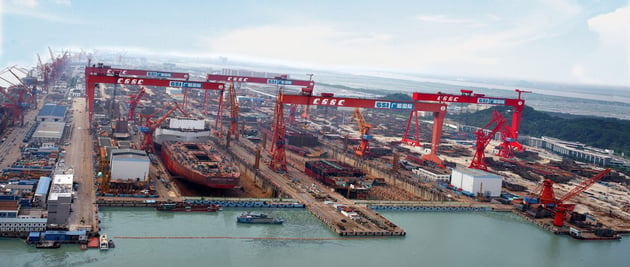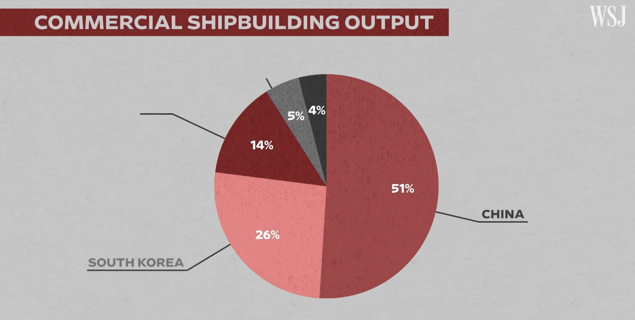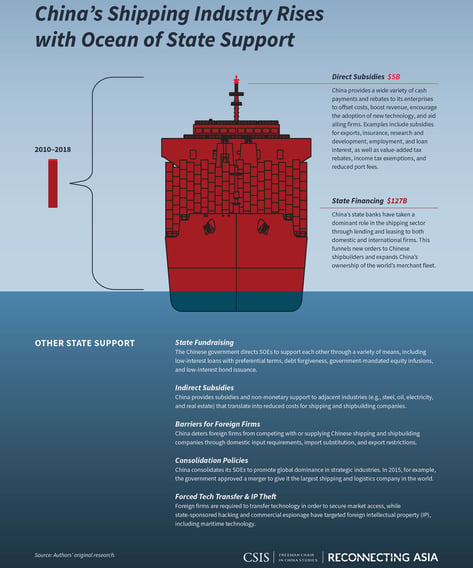The U.S is getting dominated by Chinese shipbuilders.
Chinas owns over half the global shipping production and continues to grow. The US must pivot to stay in the race.
5/22/20244 min read


China is dominating the world in shipbuilding, especially the United States.
As of 2024 China owns over 51% of market share for all ship production. The United States ship production is estimated at just 1% of world output. There could be drastic implications for the United States as its position in the global economy keeps changing with the ever present Chinese rise.
Chinese shipbuilding is an absolute massive industry compared to the US straight up. Just by capacity standards, China has 200 times the shipbuilding capacity as the US. China has one shipyard, found on Changing Island that puts out more production than the entirety of shipyards in America.


Much like Americas rise during the Industrial revolution, the Chinese shipbuilding industry has grown lock step and barrel with the overall economic rise of the entire country as a whole. Building on the wealth each citizen has been acquiring over the last 30 years. At least 100 billion dollars has been injected into building new ships. With this type of leverage China has been able to build up a huge navy. The biggest in the world nowadays by haul count.


According to the U.S department of Defense China now has 370 battle force ships. That is 78 more ships than the current US fleet at 292 ships. By 2030 China aims to be at 435 ships, while the US aims to be with two less ships at 290.
More ships obviously don’t mean superiority, but it is one indicator of greater power.
The U.S has less ships, but they are bigger. The US still has a higher ability for firepower. Our ships can carry more missiles and use them more easily with support of planes and carriers. Meaning the navy can more easily project power in more areas across vast distances.
The U.S still carries the advantage in aircraft carries boasting 11 compared to Chinas 2. However, the projector may not always be in favor of the United States. satellite images confirmed by CSIS that the Chinese are making progress on their 3rd aircraft carrier. As our carriers age and the timeline for repairs and upgrades get dragged out, its possible by the end of the decade China may be much more of a competitor.
Its very unlikely China will try to create 10 more aircraft carriers in an attempt to overthrow the Unites States carrier superiority. China doesn’t have a need for them as they do not have the same global footprint as the United States nor do the desire to match that global footprint. The Chinese are trying to bridge the technological gap that the Unites States owns over them through the use of these vessels.
The main reason China has been able to achieve this market domination is through investment. China has heavily subsidized its shipyards. Much like the Unites States did for the majority of the 20th century the government rewarded these investments and helped build up the behavior. Unfortunately, that behavior was gutted in the United States in the 1980s with the Reagan administration.
All this time countries like Japan, South Korea, and of course China have run the opposite course. China has thrown heavy subsidies to the ship yard itself. Focusing on dual use, which includes dry docking and assembly/fabrication halls. This means that the yard can put out massive production quickly and keep repeating the process over and over. The dual usage yard also allows for orders to be fulfilled for commercial or military vessels.
This is one key difference in understanding why the Chinese are dominating the ship building industry. Unites States shipyards rely on one major but vast customer. The US navy. 80 percent of all shipbuilding contracts in the Unites States come from the navy. This creates a dynamic where our shipyards become dependent on naval budgets and priorities rather than leaning on a commercial industry. Many Us shipyards have grown reliant on one customer which spells disaster for investing more capitol when they are already facing backlog problems and supply chain failures.
The navy says that their problem has become twofold. One being that their current fleet is much past its prime and repairs are costly that take forever to get done. Two being that new shipbuilding has become extremely expensive in the Unites states and it takes longer than repairs to the old ships.
Its does seem the United States does understand they are falling behind as they have increased the shipbuilding budget by a huge amount in the last 8 years to upwards of 28 billion dollars. This is the largest part of the pentagon budget the last few fiscal years.
This may be a good time to evaluate our abilities and lean on our trading partners for help. Afterall, Japan and South Korea are the next big players in shipbuilding. Why not deploy that money directly to have our partners build what we cannot?
